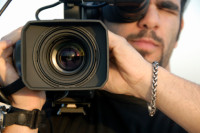 According to Jan Ozer, streaming media expert, author and Publisher of the Streaming Learning Center, there are a number of things to consider when you are shooting video for streaming. Ozer says, “Anyone who’s ever picked up a camcorder and tried to tap into their inner- Spielberg knows that there’s a lot more to creating a high-quality, impactful movie than turning on the camcorder and pressing the red record button. The same is true with producing video for streaming.” (From Shooting for Streaming – Five Key Tips)
According to Jan Ozer, streaming media expert, author and Publisher of the Streaming Learning Center, there are a number of things to consider when you are shooting video for streaming. Ozer says, “Anyone who’s ever picked up a camcorder and tried to tap into their inner- Spielberg knows that there’s a lot more to creating a high-quality, impactful movie than turning on the camcorder and pressing the red record button. The same is true with producing video for streaming.” (From Shooting for Streaming – Five Key Tips)
- Choosing a background – “When a video has lots of detail in the background — like bookshelves, a finely patterned wallpaper, or blowing leaves — the codec can’t tell whether you care about the subject’s face or the extraneous stuff in the background. So it tries to preserve the quality of all the content in the frame, which inevitably degrades the quality of what you care most about.”
- Lighting the set – “In terms of lighting style, you can use three-point lighting, which produces slight shadows on the face, or flat lighting, with no appreciable shadows. Either way, the most important priority is to provide sufficient lighting for the camcorder to achieve good exposure without injecting gain into the video.”
- Camera usage and selection – “If you’re shooting in a controlled environment, like a classroom or conference room, it’s best to move that camera out of automatic mode, and control exposure manually, which fortunately is easier than it sounds. Basically, there are three controls that control how much light gets to the camcorder’s sensing device; shutter speed, gain, and aperture.”
- Framing the shot – “The Rule of Thirds is a principle of photographic image composition that can also be applied to shooting video. Imagine the video frame divided into thirds, both horizontally and vertically like tic-tac-toe board. If the subject is facing the camera, the top horizontal line should be at eye level and they should be in the center of the frame.”
- Don’t forget about audio – “Don’t skimp on the audio side of the equation. Viewers accept some visual degradation in their streaming media, but not audio-related deficits, since they know that audio can be nearly perfect, even when delivered via streaming.”